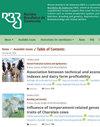How do relocation time and length of storage after relocation affect fermentation and nutritive value of corn silage?
IF 1.2
4区 农林科学
Q3 Agricultural and Biological Sciences
Revista Brasileira De Zootecnia-Brazilian Journal of Animal Science
Pub Date : 2023-03-03
DOI:10.37496/rbz5220220059
引用次数: 0
Abstract
- This study aimed to determine the effects of relocation time (RT; Experiment 1) and storage time after relocation (ST; Experiment 2) on microbial population, fermentative characteristics, and chemical composition of corn silage. In experiment 1, corn silage was stored for 30 d, subjected to different RT (0–60 h), and stored again for 30 d. Thirty experimental silos were used in a completely randomized design, with three replicates per treatment. In experiment 2, after 150 d of ensiling, silage was removed from a bunker silo, exposed to air for 9 h, relocated to experimental silos, and stored for periods ranging from 0 to 128 d. Twenty-eight experimental silos were used in a completely randomized design, with four replicates per treatment. Relocation time had no effect on fungi counts and concentrations of lactic and propionic acids in corn silage but resulted in a significant increase in dry matter content. In experiment 2, dry matter recovery and concentration of non-fiber carbohydrates decreased in corn silage stored for more than 32 d after relocation. Exposure of corn silage to air during relocation for up to 60 h followed by 30 d of storage did not compromise the fermentation profile or nutritive value of the silage. Increased storage time of relocated corn silage (up to 128 d) consistently decreases its nutritional value. The storage period seems to have an increased impact on nutrient loss in relocated silage than the relocation period.迁移后的迁移时间和存储长度对玉米青贮发酵和营养价值有何影响?
本文章由计算机程序翻译,如有差异,请以英文原文为准。
求助全文
约1分钟内获得全文
求助全文
来源期刊
CiteScore
1.90
自引率
0.00%
发文量
25
审稿时长
8 weeks
期刊介绍:
The Revista Brasileira de Zootecnia (RBZ; Brazilian Journal of Animal Science) encompasses all fields of Animal Science Research. The RBZ publishes original scientific articles in the areas of Aquaculture, Biometeorology and Animal Welfare, Forage Crops and Grasslands, Animal and Forage Plants Breeding and Genetics, Animal Reproduction, Ruminant and Non-Ruminant Nutrition, and Animal Production Systems and Agribusiness.

 求助内容:
求助内容: 应助结果提醒方式:
应助结果提醒方式:


